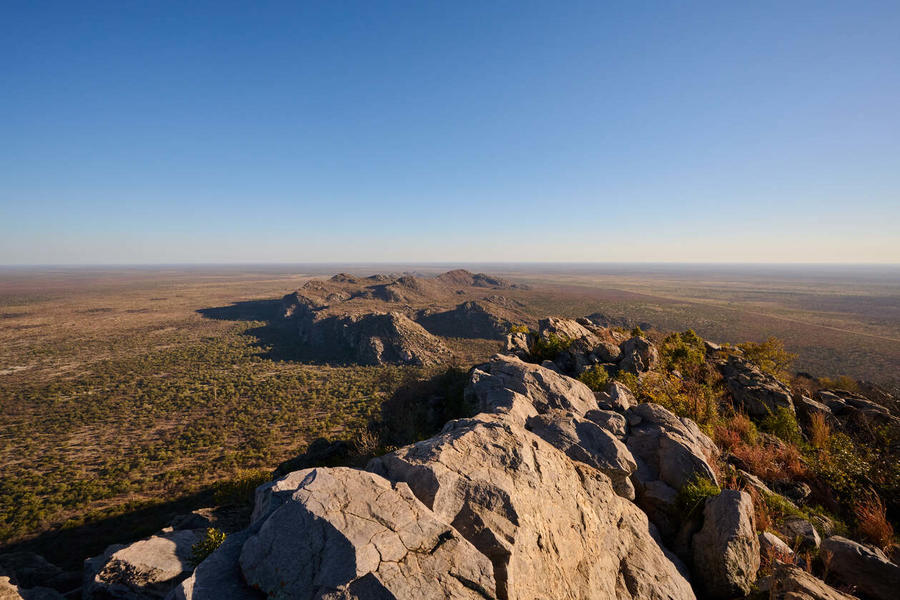Tsodilo Hills Sleep-Out Camp Expedition
TSODILO HILLS SLEEP-OUT EXPEDITION AS AN EPIC EXPERIENCE ITINERARY
For added value, exclusivity, and privacy, book the Sleep-Out Expedition as an Epic Experience. What sets this apart from the 3-night inclusive journey?
· Optional exclusive use of the Tsodilo Hills Sleep-Out Camp (maximum 8 adults and children; availability dependent).
· Hosted by a specialist guide for the duration as an expert on the history of the Kalahari Bushman cultures.
· A local San Bushman host and interpreter, if required.
· Sunrise summit hike of Botswana’s highest peak, the Male Hill, for those who wish.
· Spend an afternoon with the locals from the Nxamaseri community, learning about modern African
culture, foraging for local food, fishing, and harvesting reeds for construction and basket weaving.
· Scenic helicopter transfers over the Okavango Panhandle and Tsodilo Hills.
· Supporting the local community with donations going towards homegrown projects within the area.
Sleep-Out Camp Facilities & Details:
· Tsodilo Hills is a UNESCO World Heritage Site renowned for its spiritual significance, captivating rock art, and Botswana’s highest peak—the Male Hill. The Sleep-Out camp, the first of its kind, is positioned near the base of the hills, offering unprecedented access to the magic of this place and stunning views from your tent.
· Designed to minimise its ecological impact, the camp accommodation is basic yet beautiful and accommodates a maximum of 8 guests and 2 children.
· The sleep-out camp has three twin/double pods (two adults per pod maximum) plus one family dwelling with two pods accommodating a maximum of two adults and two children (under 16 years old).
· Canvas pods are set on elevated platforms beneath the sheltering canopy of Zambezi Teak trees, and have screens to keep mosquitos and insects at bay.
· Pod interiors are quaint and feature comfortable floor-based mattresses with plush duvets and pillows for a touch of luxury amid the wilderness. There’s a small table for drinking water and a torch.
· Private outdoor bathrooms are positioned next to each tent. They include a “bush toilet” and an innovative and eco-friendly bucket shower, as well as a basic vanity. Kindly note that camp staff need to be briefed to prepare warm water for showering. Bathrooms have overhead covering.
· This is a wilderness experience. While the Tsodilo area see little in the way of large quantities of elephant or predators, the area is still in the wilderness and guests are advised to be escorted by guides and camp staff during the evening/early mornings.
· In addition to hiking the Male hill, trekking to see ancient rock art and learning from local San people, enjoy a wilderness trail and interpretive walk around the camp property exploring the desert flora and fauna with your local guide.
· There is no Wi-Fi and no cell phone reception. Time to disconnect and become one with nature. In case of emergency, we have a satellite phone and emergency support.
· There is no electricity or back-up power. Guest with quiet lithium battery powered c-pap machines may be able to join the Sleep-Out but anybody with pre-existing medical conditions should seek medical advice.
PLEASE NOTE THE FOLLOWING FAQS BEFORE BOOKING
How difficult are the Tsodilo trails? To summit Male Hill, a good level of fitness is required. The trail involves an elevation gain of about 400 meters from base to summit. The rocky sections demand sturdy walking shoes and balance, making it suitable only for regular walkers or hikers. Other walking trails can be tailored to suit your fitness level, but all guests should be able to comfortably walk 2-3 km at a leisurely pace, occasionally navigating small rocks and sandy paths.
What if guests are unable to walk for any reason? For those who wish to see the paintings and experience the Tsodilo Sleep-Out camp but have concerns about walking challenges, it's recommended to discuss your needs with the booking consultant at the time of booking. A vehicle can be arranged to transport guests between painting sites with minimal walking required, but this must be pre-planned.
What’s the weather like? Expect typical desert temperatures that range dramatically.
· April-August: Days are warm (25-35ºC) and evening temps can be near freezing. Extra blankets and hot water bottles are provided. It’s essential to pack warm clothing, including warm sleepwear.
· September-November: Days are very hot (35-40+ºC). Temperatures drop quickly at sunset and the evenings are pleasant to cool. Despite the extremely warm temperatures of the day, the evenings can still be chilly.
· November-March: The first rains typically arrive in November, bringing short tropical-like storms. Covered areas around the camp provide shelter, and the Sleep-Out pods are water-tight. Insects, especially flying ants and moths, are common around lights in the summer, particularly after rains. If you're uncomfortable with insects, it's best to avoid summer months. While days are hot and humid, the summer light and colours are truly spectacular.
What should guests pack? As space in the camp is limited you need to pack light. You cannot bring your entire holiday suitcase with you. We suggest bringing a light foldable duffle bag or daypack in your main bag which can be used to carry your toiletries and overnight things.
· Usual safari gear (camera, binoculars etc.)
· Warm woolly hat
· Warm jacket/fleece
· Walking poles for those who require support to reach the summit (not compulsory)
· Head torch recommended to help at night/early morning
· Good walking shoes (trail runners also good)
· Long trousers for walking are always re commended
What if guests want to see Tsodilo Hills but not sleep over? Day trips are available for those who prefer not to overnight. You’ll enjoy a guided walk or hike and lunch before making a same day return to the lodge.





